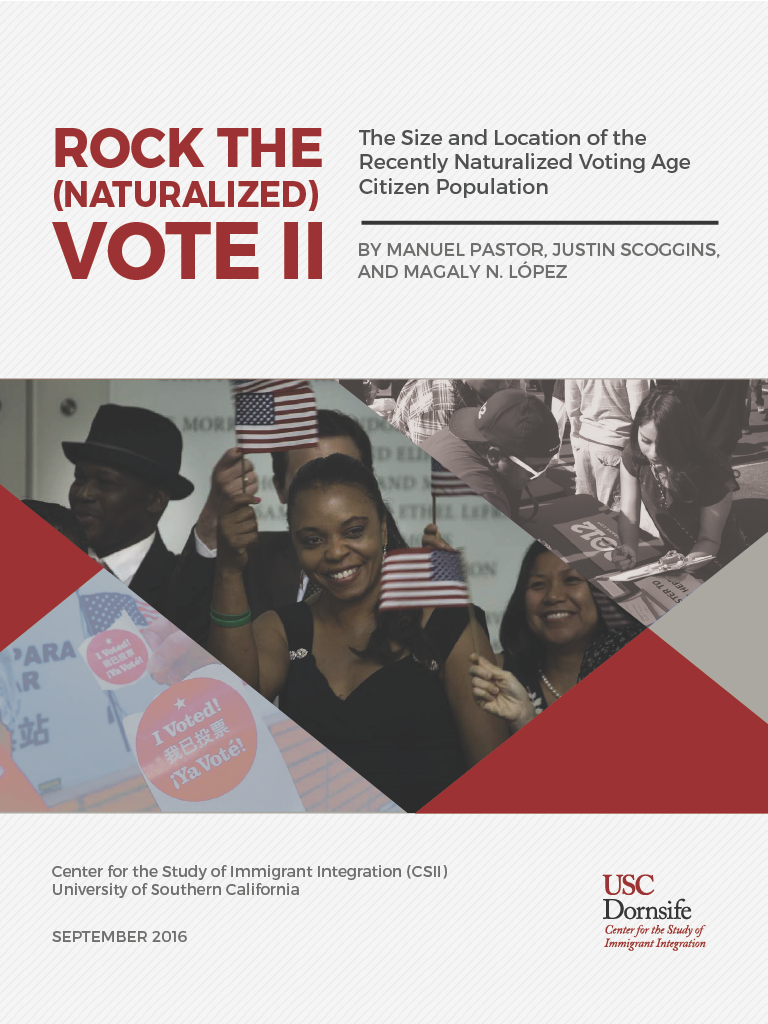
September 2016
By Manuel Pastor, Justin Scoggins, and Magaly N. López
Please note: reports dated earlier than June 2020 were published under our previous names: the USC Program for Environmental and Regional Equity (PERE) or the USC Center for the Study of Immigrant Integration (CSII).
Drawing upon the recently released 2015 American Community Survey, Rock the (Naturalized) Vote II seeks to demonstrate the potential impact and importance of recently naturalized immigrants in the 2016 election. With immigration once again taking center stage in one of the most divisive and polarizing presidential elections, CSII’s 2016 update of an earlier 2012 analysis focuses on the recently naturalized voting age citizens—a group that may be motivated by and sensitive to the dynamics of immigration issues. As before, the research brief is accompanied by an interactive map (see below). We hope that our new report and online tool will be useful to activists, agencies, and civic and business leaders across the U.S. working on civic engagement efforts with naturalized voting-eligible populations.
Rock the (Naturalized) Vote II is an update of CSII’s 2012 report which estimated the size and location of recently naturalized voting age citizen population and put forth an analysis of their electoral impact in national politics.
With immigration once again taking center stage in the 2016 presidential elections, CSII’s latest brief seeks to answer: What are the potential impacts of this new immigrant voting bloc? How sizeable is the potential immigrant vote, where do potential voters live, and could they make a difference in battleground and other states?
CSII’s analysis includes data at the state level but also uses the most recent American Community Survey data (released on September 15, 2016 by the U.S. Census Bureau) to generate estimates at the sub-state level. CSII releases this brief and map just ahead of many voter registration deadlines across the U.S. in the hopes that this detailed data will be useful for those conducting last-minute voter registration and mobilization efforts in key areas.
The brief includes:
- A discussion of the registration and voting tendencies of the recently naturalized, and the effect that polarized debates about immigration may have on these potential voters.
- A description of the methodology used to generate our estimates of the size and location of the recently naturalized—offering an update of our most recent look by state, within state, and by country/region of origin and ethnicity.
- An analysis of what these data suggest for future efforts in the realms of voter registration, civic engagement, and policy change.
- An appendix with detailed tables, an extensive list of resources (national and regional), and a table of voter registration deadlines by state.
Rock the (Naturalized) Vote II is an update of CSII’s 2012 report, which estimated the size and location of recently naturalized voting age citizen population and put forth an analysis of their electoral impact in national politics.
Download brief
2016 Interactive Map
This interactive map presents CSII’s latest estimates of the size of the recently naturalized adult population and their composition by race/ethnicity and country/region of origin. The map itself plots recently naturalized (those naturalizing since 2005), somewhat recently naturalized (those naturalizing since 1995) and all naturalized adults as a share of the citizen voting age population (CVAP)—a measure of the voting eligible population.
*Please note: This map is best viewed in Google Chrome.
There are three measures the can be mapped by clicking on the check boxes above the map legend:
- “Recently naturalized (since 2005)” is the default setting and maps recently naturalized adults as a share of the CVAP—a group that is most likely to represent new voters, and may be most sensitive to the dynamics of the immigration debate.
- “Naturalized since 1995” plots the somewhat recently naturalized adults as a share of the CVAP—a larger group of potential immigrant voters who also may be swayed by immigration issues.
- “All naturalized” plots all naturalized adults as a share of the CVAP—the broadest measure of the size of the potential immigrant vote.
In addition, the map can be displayed at two different geographies by clicking on the check boxes beneath the map legend: Public Use Microdata Areas (PUMAs) or states.
Upon hovering over any state or PUMA, a table with detailed information on the size of the naturalized adult population by recency of naturalization (and their share of the CVAP) will appear. The table also reports (sample size permitting) the racial/ethnic and country/region of origin composition for just the recently naturalized adults in each geography—a group that is the focus of the map and the accompanying report. Please note that in the reporting the racial/ethnic composition of the recently naturalized, “AANHPI” refers to the Asian American, Native Hawaiian, and Pacific Islander population.
We hope this tool will be useful to activists, agencies, and civic and business leaders across the U.S. working on civic engagement efforts with naturalized voter populations.



